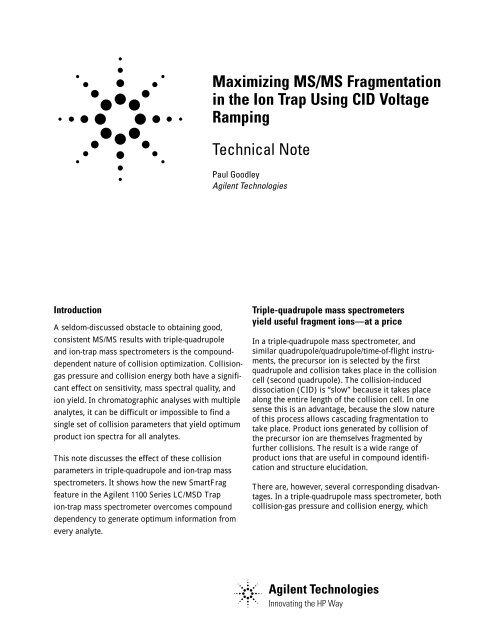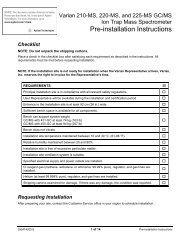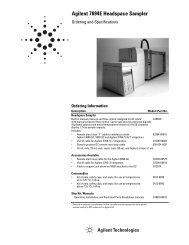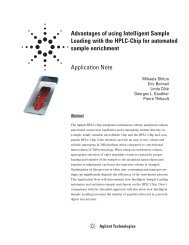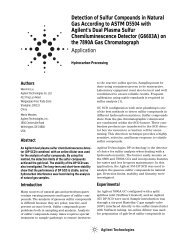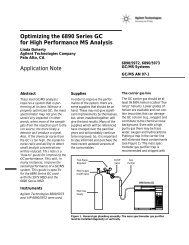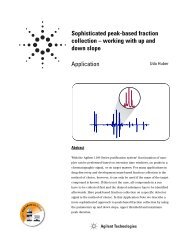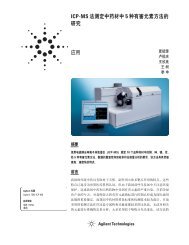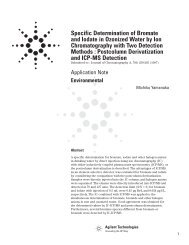Maximizing MS/MS Fragmentation in the Ion Trap Using CID Voltage ...
Maximizing MS/MS Fragmentation in the Ion Trap Using CID Voltage ...
Maximizing MS/MS Fragmentation in the Ion Trap Using CID Voltage ...
Create successful ePaper yourself
Turn your PDF publications into a flip-book with our unique Google optimized e-Paper software.
<strong>Maximiz<strong>in</strong>g</strong> <strong>MS</strong>/<strong>MS</strong> <strong>Fragmentation</strong><strong>in</strong> <strong>the</strong> <strong>Ion</strong> <strong>Trap</strong> Us<strong>in</strong>g <strong>CID</strong> <strong>Voltage</strong>Ramp<strong>in</strong>gTechnical NotePaul GoodleyAgilent TechnologiesIntroductionA seldom-discussed obstacle to obta<strong>in</strong><strong>in</strong>g good,consistent <strong>MS</strong>/<strong>MS</strong> results with triple-quadrupoleand ion-trap mass spectrometers is <strong>the</strong> compounddependentnature of collision optimization. Collisiongaspressure and collision energy both have a significanteffect on sensitivity, mass spectral quality, andion yield. In chromatographic analyses with multipleanalytes, it can be difficult or impossible to f<strong>in</strong>d as<strong>in</strong>gle set of collision parameters that yield optimumproduct ion spectra for all analytes.This note discusses <strong>the</strong> effect of <strong>the</strong>se collisionparameters <strong>in</strong> triple-quadrupole and ion-trap massspectrometers. It shows how <strong>the</strong> new SmartFragfeature <strong>in</strong> <strong>the</strong> Agilent 1100 Series LC/<strong>MS</strong>D <strong>Trap</strong>ion-trap mass spectrometer overcomes compounddependency to generate optimum <strong>in</strong>formation fromevery analyte.Triple-quadrupole mass spectrometersyield useful fragment ions—at a priceIn a triple-quadrupole mass spectrometer, andsimilar quadrupole/quadrupole/time-of-flight <strong>in</strong>struments,<strong>the</strong> precursor ion is selected by <strong>the</strong> firstquadrupole and collision takes place <strong>in</strong> <strong>the</strong> collisioncell (second quadrupole). The collision-<strong>in</strong>duceddissociation (<strong>CID</strong>) is “slow” because it takes placealong <strong>the</strong> entire length of <strong>the</strong> collision cell. In onesense this is an advantage, because <strong>the</strong> slow natureof this process allows cascad<strong>in</strong>g fragmentation totake place. Product ions generated by collision of<strong>the</strong> precursor ion are <strong>the</strong>mselves fragmented byfur<strong>the</strong>r collisions. The result is a wide range ofproduct ions that are useful <strong>in</strong> compound identificationand structure elucidation.There are, however, several correspond<strong>in</strong>g disadvantages.In a triple-quadrupole mass spectrometer, bothcollision-gas pressure and collision energy, which
<strong>Maximiz<strong>in</strong>g</strong> <strong>MS</strong>/<strong>MS</strong> <strong>Fragmentation</strong> <strong>in</strong> <strong>the</strong> <strong>Ion</strong> <strong>Trap</strong> Us<strong>in</strong>g <strong>CID</strong> <strong>Voltage</strong> Ramp<strong>in</strong>gAgilent Technologiesis controlled by <strong>the</strong> collision-cell voltage, havesignificant effects on analytical results. Both mustbe optimized <strong>in</strong> order to achieve <strong>the</strong> best analyticalresults. Because optimum sett<strong>in</strong>gs are compounddependent, sett<strong>in</strong>gs that produce good results for<strong>the</strong> first compound to elute may yield poor resultsfor <strong>the</strong> next compound. A triple-quadrupole massspectrometer must be able to change sett<strong>in</strong>gs foreach analyte to produce optimum results.Traditional ion traps havea different set of challengesThe ion trap works somewhat differently. Theprecursor ions are held near <strong>the</strong> center of <strong>the</strong> trap<strong>in</strong> a conf<strong>in</strong>ed space. The collision time tends to beshorter (faster), allow<strong>in</strong>g little or no time for fur<strong>the</strong>rfragmentation of <strong>the</strong> product ions. The result isfewer product ions and less structural <strong>in</strong>formation.Traditionally, this was compensated for by us<strong>in</strong>g<strong>the</strong> ion trap’s ability to perform more levels of<strong>MS</strong> analysis to cont<strong>in</strong>ue select<strong>in</strong>g and fragment<strong>in</strong>gproduct ions. Indeed, this is a very powerfultechnique that allows structure to be determ<strong>in</strong>ed<strong>in</strong> a very controlled fashion. Recent <strong>in</strong>novations,however, allow <strong>the</strong> Agilent ion trap to generatemore structural <strong>in</strong>formation with fewer steps of<strong>MS</strong> and at <strong>the</strong> same time overcome <strong>the</strong> compounddependentnature of collision optimization.In <strong>the</strong> ion trap, <strong>the</strong> collision gas, generally helium,reduces <strong>the</strong> k<strong>in</strong>etic energy of <strong>the</strong> <strong>in</strong>com<strong>in</strong>g ions as<strong>the</strong>y approach <strong>the</strong> center of <strong>the</strong> trap. The amountof gas <strong>in</strong> <strong>the</strong> trap is generally fixed and is notchanged for different compounds. This leaves onevariable, collision energy, with a significant andcompound-dependent <strong>in</strong>fluence over fragmentation.<strong>CID</strong> voltage ramp<strong>in</strong>g <strong>in</strong> <strong>the</strong> ion trapprovides <strong>the</strong> best of both worldsA new feature, <strong>CID</strong> voltage ramp<strong>in</strong>g (SmartFrag),is built <strong>in</strong>to firmware of <strong>the</strong> Agilent 1100 SeriesLC/<strong>MS</strong>D <strong>Trap</strong>. <strong>CID</strong> voltage ramp<strong>in</strong>g elim<strong>in</strong>ates <strong>the</strong>need to optimize <strong>the</strong> collision energy for differentcompounds. Each time <strong>MS</strong>/<strong>MS</strong> is performed, <strong>CID</strong>voltage ramp<strong>in</strong>g quickly ramps <strong>the</strong> collision voltageover a range of energies. This ensures that eachcompound receives <strong>the</strong> correct energy for optimumfragmentation. It also results <strong>in</strong> a higher level offragmentation, provid<strong>in</strong>g more structural <strong>in</strong>formationwith fewer steps of <strong>MS</strong>/<strong>MS</strong>.Figure 1a shows <strong>the</strong> full-scan mass spectrumof prednisone, an anti-<strong>in</strong>flammatory steroid hav<strong>in</strong>ga protonated molecular ion [M+H] + at m/z 359.Figure 1b depicts <strong>the</strong> <strong>MS</strong>/<strong>MS</strong> full-scan spectrumobta<strong>in</strong>ed at a fixed collision energy of 0.8v. The<strong>MS</strong>/<strong>MS</strong> spectrum yields a large precusor ion anda few product ions which show m/z losses for awater molecule and for a water molecule and CO(total of 46). Figure 1c shows <strong>the</strong> same <strong>MS</strong>/<strong>MS</strong>full-scan spectrum obta<strong>in</strong>ed us<strong>in</strong>g <strong>the</strong> <strong>CID</strong> voltageramp<strong>in</strong>g. The spectrum is rich with product ionsprovid<strong>in</strong>g much structural <strong>in</strong>formation.2
<strong>Maximiz<strong>in</strong>g</strong> <strong>MS</strong>/<strong>MS</strong> <strong>Fragmentation</strong> <strong>in</strong> <strong>the</strong> <strong>Ion</strong> <strong>Trap</strong> Us<strong>in</strong>g <strong>CID</strong> <strong>Voltage</strong> Ramp<strong>in</strong>gAgilent TechnologiesIntens× 10 6 <strong>Ion</strong>-<strong>Trap</strong> Full-Scan <strong>MS</strong> of1.5 Prednisone; Molecular <strong>Ion</strong>at m/z 359OCH 3CH 2 OHCH 3OOH+ All <strong>MS</strong>, 3.0 m<strong>in</strong> (#2)359.11.0O[M + H] +a0.50.0200 220 240 260 280 300 320 340 360m/zIntens+ <strong>MS</strong>/<strong>MS</strong> (359), 0.9 m<strong>in</strong> (#46)× 10 6 Full-Scan <strong>CID</strong> <strong>MS</strong>/<strong>MS</strong> ofO359.1m/z 359; Non-rampedCH 2 OHCH 31.0 <strong>CID</strong> <strong>Voltage</strong>OOH0.8CH 30.6O0.40.2313.2341.10.0200 220 240 260 280 300 320 340 360 m/z×Intens10 52.5+ <strong>MS</strong>/<strong>MS</strong> (359), 1.3 m<strong>in</strong> (#5)Full-Scan <strong>CID</strong> <strong>MS</strong>/<strong>MS</strong> ofO CH 2 OH341.1CHm/z 359; us<strong>in</strong>g Ramped3OOH<strong>CID</strong> <strong>Voltage</strong>CH 32.0313.01.5O323.0295.01.0305.00.5212.9267.0186.9237.1 253.1 277.0287.00.0200 220 240 260 280 300 320 340 360 m/z[M + H – 46] +[M + H – 2 (H 2 0)] +[M + H – H 2 0] +[M + H – H 2 0] +[M + H] +bcFigure 1. <strong>MS</strong>/<strong>MS</strong> of Prednisone us<strong>in</strong>g <strong>CID</strong> voltage ramp<strong>in</strong>g3
<strong>Maximiz<strong>in</strong>g</strong> <strong>MS</strong>/<strong>MS</strong> <strong>Fragmentation</strong> <strong>in</strong> <strong>the</strong> <strong>Ion</strong> <strong>Trap</strong> Us<strong>in</strong>g <strong>CID</strong> <strong>Voltage</strong> Ramp<strong>in</strong>gAgilent TechnologiesFigure 2a is a full-scan mass spectrum of <strong>the</strong>antihypertensive, Labetalol, hav<strong>in</strong>g a protonatedmolecular ion at m/z 329. Figure 2b shows <strong>MS</strong>/<strong>MS</strong>of <strong>the</strong> precursor ion yield<strong>in</strong>g a major ion at m/z 311,which corresponds to <strong>the</strong> loss of a water molecule.The spectrum is nearly bare of product ions, present<strong>in</strong>g<strong>the</strong> need for more stages of <strong>MS</strong> to more fullyconfirm <strong>the</strong> molecular structure. If this occurs witha triple-quadrupole system, <strong>the</strong> option for <strong>MS</strong> 3 doesnot exist and o<strong>the</strong>r confirmatory approaches may beneeded. Figure 2c shows <strong>MS</strong>/<strong>MS</strong> of Labetalol us<strong>in</strong>g<strong>CID</strong> voltage ramp<strong>in</strong>g. The full-scan <strong>MS</strong>/<strong>MS</strong> production spectrum is rich with product ions and <strong>the</strong> mostabundant ion <strong>in</strong> <strong>the</strong> spectrum is at m/z 207. Thisprovides much more structural <strong>in</strong>formation than <strong>the</strong>s<strong>in</strong>gle ion at m/z 311.Intens× 10 5 <strong>Ion</strong>-<strong>Trap</strong> Full-Scan <strong>MS</strong>Yields Molecular <strong>Ion</strong>6 at m/z 3294H 2 NHOOOHHNCH 3+ All <strong>MS</strong>, 1.4 m<strong>in</strong> (#54)329.2[M + H] +a2Labetalol0100 125 150 175 200 225 250 275 300 325 m/zIntens× 10 51.51.00.50.0Intens× 10 43210Classical <strong>Ion</strong> <strong>Trap</strong> Without<strong>CID</strong> <strong>Voltage</strong> Ramp<strong>in</strong>gFull-Scan <strong>CID</strong> <strong>MS</strong>/<strong>MS</strong>OYields Major <strong>Ion</strong>Has Loss of Water2 Nat m/z 311HOFull-Scan <strong>CID</strong> <strong>MS</strong>/<strong>MS</strong>of m/z 329 us<strong>in</strong>g <strong>CID</strong><strong>Voltage</strong> Ramp<strong>in</strong>g147.1162.1179.1190.1207.1207.1H 2 N100 125 150 175 200 225 250 275 300 325 m/zHOOOHHN266.1+ <strong>MS</strong>/<strong>MS</strong> (329/311), 2.9 m<strong>in</strong> (#84)311.2100 125 150 175 200 225 250 275 300 325 m/zOHHNCH 3CH 3294.2+ <strong>MS</strong>/<strong>MS</strong> (329/311), 3.3 m<strong>in</strong>294.2[M + H – H 2 0] +311.2[M + H – H 2 0] +bcFigure 2. <strong>MS</strong>/<strong>MS</strong> of Labetalol us<strong>in</strong>g <strong>CID</strong> voltage ramp<strong>in</strong>g4
<strong>Maximiz<strong>in</strong>g</strong> <strong>MS</strong>/<strong>MS</strong> <strong>Fragmentation</strong> <strong>in</strong> <strong>the</strong> <strong>Ion</strong> <strong>Trap</strong> Us<strong>in</strong>g <strong>CID</strong> <strong>Voltage</strong> Ramp<strong>in</strong>gAgilent TechnologiesFigure 3 is ano<strong>the</strong>r example of <strong>the</strong> use of <strong>CID</strong>voltage ramp<strong>in</strong>g. Figure 3a is <strong>the</strong> full-scan massspectrum of 4-hydroxytamoxifen, a compound for<strong>the</strong> treatment of breast cancer. Figure 3b showsresult of <strong>MS</strong>/<strong>MS</strong> of tamoxifen at a fixed collisionvoltage of 0.9 V. Although <strong>the</strong> spectrum yields sixto seven ions useful for structural characterization,<strong>the</strong> precusor ion is not totally fragmented. Fur<strong>the</strong>ranalysis would be required to f<strong>in</strong>d <strong>the</strong> optimum<strong>CID</strong> voltage to obta<strong>in</strong> a more spectral-rich production spectrum. Without o<strong>the</strong>r experimental changes,switch<strong>in</strong>g to <strong>CID</strong> voltage ramp<strong>in</strong>g generated <strong>the</strong>product ion spectrum shown <strong>in</strong> Figure 3c.Intens× 10 6 <strong>Ion</strong>-<strong>Trap</strong> Full-Scan <strong>MS</strong>5 Yields Molecular <strong>Ion</strong>at m/z 388432CH 3OHONCH 3CH 3+ <strong>MS</strong>/<strong>MS</strong> (388), 0.8 m<strong>in</strong>388.2[M + H] +a14-Hydroxytamoxifen03210100 150 200 250 300 350 400 m/zIntens× 10 5 Full-Scan <strong>CID</strong> <strong>MS</strong>/<strong>MS</strong>4 of m/z 388; Non-ramped<strong>CID</strong> voltage128.9 144.9166.1209.1223.1249.1+ <strong>MS</strong>/<strong>MS</strong> (388), 5.3 m<strong>in</strong>100 150 200 250 300 350 400 m/zFull-Scan <strong>CID</strong> <strong>MS</strong>/<strong>MS</strong>Intens of m/z 388 us<strong>in</strong>g <strong>CID</strong>× 10 4 <strong>Voltage</strong> Ramp<strong>in</strong>g3210166.1183.1223.1CH 3128.9 145.0249.1194.1OHCH 3265.1287.1OOH287.1 301.2100 150 200 250 300 350 400 m/zN316.2316.2CH 3CH 3343.2O343.2[M + H – 45] +NCH 3CH 3388.2[M + H] ++ <strong>MS</strong>/<strong>MS</strong> (388), 2.5 m<strong>in</strong>[M + H – 45] +bcFigure 3. <strong>MS</strong>/<strong>MS</strong> of 4-hydroxytamoxifen us<strong>in</strong>g <strong>CID</strong> voltage ramp<strong>in</strong>g5
<strong>Maximiz<strong>in</strong>g</strong> <strong>MS</strong>/<strong>MS</strong> <strong>Fragmentation</strong> <strong>in</strong> <strong>the</strong> <strong>Ion</strong> <strong>Trap</strong> Us<strong>in</strong>g <strong>CID</strong> <strong>Voltage</strong> Ramp<strong>in</strong>gAgilent TechnologiesConclusionsUs<strong>in</strong>g <strong>the</strong> <strong>CID</strong> voltage ramp<strong>in</strong>g feature of <strong>the</strong>Agilent LC/<strong>MS</strong>D <strong>Trap</strong> ion-trap mass spectrometerelim<strong>in</strong>ates <strong>the</strong> need for time-consum<strong>in</strong>g collisionvoltageoptimization. By sett<strong>in</strong>g a range of <strong>CID</strong>voltages us<strong>in</strong>g <strong>the</strong> SmartFrag sett<strong>in</strong>g, an analystcan be certa<strong>in</strong> to obta<strong>in</strong> fragment-rich, full-scanproduct-ion spectra for identity confirmation orstructure elucidation.For more <strong>in</strong>formation on our products and services, you can visit our siteon <strong>the</strong> World Wide Web at: http://www.agilent.com/chemAgilent Technologies shall not be liable for errors conta<strong>in</strong>ed here<strong>in</strong> or for<strong>in</strong>cidental or consequential damages <strong>in</strong> connection with <strong>the</strong> furnish<strong>in</strong>g,performance or use of this material.Information, descriptions and specifications <strong>in</strong> this publication aresubject to change without notice.Copyright © 2000Agilent TechnologiesAll rights reserved.Reproduction and adaptation is prohibited.Pr<strong>in</strong>ted <strong>in</strong> <strong>the</strong> U.S.A. November 2000(23) 5988-0704EN


